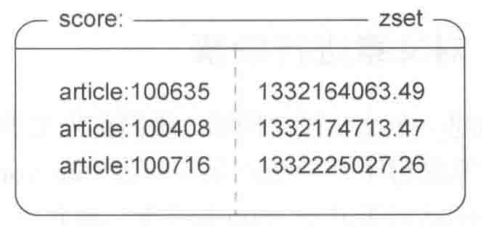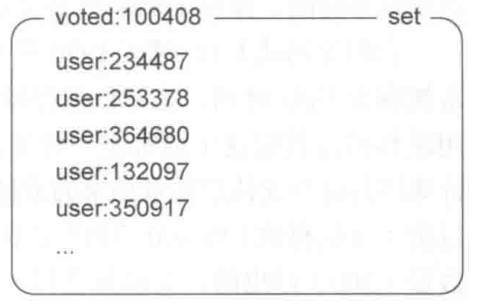一个文章发布网站,可以对文章进行一些操作:
- 发布
- 投票
- 按照时间排序得到文章列表
- 按照投票进行排序得到文章列表
- 分组
文章可以投票,规则是:如果一篇文章有 200 个以上的赞,就是一个好文章;并且网站首页每天会列出最新的 50 篇的好文章
为了能得到一个随着时间流逝而不断减少的评分,文章的评分标准就有 2 个维度:赞的个数、发布时间。具体的计算方法为:将文章的赞的数目乘以一个常量,然后加上文章的发布时间,得出的结果就是文章的评分
1 | 评分 = 赞的个数 * 常量 + 发布时间 |
使用时间戳来计算文章的发布时间,常量设置为 432。这个常量是将 1 天的秒数(60 60 24 = 86400)除以好文章需要的赞的数目(200)得到的。文章每获取一个赞,程序就需要将文章的评分加上 432 分。并且只有发布时间之后的一周内才可以进行评分,超时就不能评分了
这种需求可以利用 Redis 来实现
Redis是什么
速度非常快的非关系型数据库,可以存储键(key)与 5 种不同类型的值(value)之间的映射(mapping)
类型
键(key)都是字符串,值(value)的 5 种类型的值如下:
- 字符串
- 列表
- 哈希
- 集合
- 有序集合
所以映射关系如下:
- string: string
- string: list
- string: hash
- string: set
- string: zset
使用的数据结构
文章信息
使用 hash 来存储文章信息。比如一个 ID 为 92617 的文章,如图

操作指令如下
1 | 127.0.0.1:6379> hset article:92617 title "Go to statement considered harmful" |
文章发布时间
用 zset 存储。成员(member)为文章 ID,分值(score)为文章的发布时间

操作指令如下
1 | zadd time 1332065417 article:100408 |
文章评分
用 zset 存储。成员(member)为文章 ID,分值(score)为文章的评分

操作指令如下
1 | zadd time 1332164063 article:100635 |
文章投票
为了防止用户对同一篇文章进行多次投票,还需要为每篇文章记录记录一个已投票用户名单,可以使用 set 来存储

并且,文章发布一周之后就不能再次投票了,记录文章已投票用户名单的集合也将被删除
1 | sadd voted:100408 user:234487 |
实现
文章投票
当用户尝试对一篇文章进行投票时,程序使用 ZSCORE 命令查询文章发布时间的有序集合,判断文章发布的时间是否超过一周。如果还可以投票,使用 SADD 把用户添加到该文章的已投票用户名单的集合里。如果添加成功的话,说明用户是第一次对这篇文章进行投票,于是使用 ZINCRBY 给文章的评分增加 432 分,并使用 HINCRBY 命令对文章信息 hash 里的投票数目进行更新
1 | private static final int ONE_WEEK_IN_SECONDS = 7 * 86400; |
发布文章
发布一篇文章需要创建一个新的文章 ID,可以通过对一个计数器执行 INCR 命令来完成。接着程序使用 SADD 把文章作者的 ID 加入到已投票用户名单的集合里,并且使用 EXPIRE 命令为这个集合设置一个过期时间,Redis 会在一周之后自动删除这个集合。然后,程序使用 HMSET 命令存储文章信息,并使用两个 SADD 命令将文章的初始评分和发布时间分别添加到两个有序集合里
1 | /** |
文章列表
如何按照评分从高到低以及按照时间从新到旧的顺序得到文章列表?可以使用 ZREVRANGE 命令从时间有序列表或者评分有序列表取出多个文章 ID,然后再调用 HGETALL 命令从文章信息的 hash 里取出文章详情
因为默认是从小到大,所以才使用 ZREVRANGE 命令反过来从大到小
1 | private static final int ARTICLES_PER_PAGE = 25; |
文章分组
群组功能由两个部分组成,一个部分负责记录文章属于哪个分组,另一个负责取出群组里的文章。问了记录各个群组都存了那些文章,需要为每个群组创建一个 set,将同属一个群组的文章的 ID 放到集合里
下面是一个把文章加入群组和移出群组的方法
1 | /** |
文章分组内的文章进行排序
群组内的文章也需要按照时间或者分数来进行排序,ZINTERSTORE 命令可以接受多个集合和多个有序集合作为输入,做一个交集,找出所有同时存在于集合和有序集合中的成员
比如一个“编程”分组里的文章,对它按照分值进行排序

如果群组里的文章非常多,执行 ZINTERSTORE 命令就会比较花时间,为了减少资源占用,程序将 ZINTERSTORE 命令的计算结果缓存 60 秒
1 | public List<Map<String, String>> getGroupArticles(Jedis jedis, String groupName, int page, String order) { |
总结
熟悉 Redis 的 5 种值类型:
- 字符串
- 列表
- 哈希
- 集合
- 有序集合
同时熟悉一些相关的操作命令,这样的问题就迎刃而解了